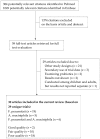Dietary Factors and Modulation of Bacteria Strains of Akkermansia muciniphila and Faecalibacterium prausnitzii: A Systematic Review
- PMID: 31336737
- PMCID: PMC6683038
- DOI: 10.3390/nu11071565
Dietary Factors and Modulation of Bacteria Strains of Akkermansia muciniphila and Faecalibacterium prausnitzii: A Systematic Review
Abstract
Akkermansia muciniphila and Faecalibacterium prausnitzii are highly abundant human gut microbes in healthy individuals, and reduced levels are associated with inflammation and alterations of metabolic processes involved in the development of type 2 diabetes. Dietary factors can influence the abundance of A. muciniphila and F. prausnitzii, but the evidence is not clear. We systematically searched PubMed and Embase to identify clinical trials investigating any dietary intervention in relation to A. muciniphila and F. prausnitzii. Overall, 29 unique trials were included, of which five examined A. muciniphila, 19 examined F. prausnitzii, and six examined both, in a total of 1444 participants. A caloric restriction diet and supplementation with pomegranate extract, resveratrol, polydextrose, yeast fermentate, sodium butyrate, and inulin increased the abundance of A. muciniphila, while a diet low in fermentable oligosaccharides, disaccharides, monosaccharides, and polyols decreased the abundance of A. muciniphila. For F. prausnitzii, the main studied intervention was prebiotics (e.g. fructo-oligosaccharides, inulin type fructans, raffinose); seven studies reported an increase after prebiotic intervention, while two studies reported a decrease, and four studies reported no difference. Current evidence suggests that some dietary factors may influence the abundance of A. muciniphila and F. prausnitzii. However, more research is needed to support these microflora strains as targets of microbiome shifts with dietary intervention and their use as medical nutrition therapy in prevention and management of chronic disease.
Keywords: Akkermansia muciniphila; Faecalibacterium prausnitzii; dietary interventions; microbiome; randomized controlled trials; systematic review.
Conflict of interest statement
The authors declare no conflict of interest.
Figures
Similar articles
-
Reduced Akkermansia muciniphila and Faecalibacterium prausnitzii levels in the gut microbiota of children with allergic asthma.Allergol Immunopathol (Madr). 2019 Jul-Aug;47(4):365-371. doi: 10.1016/j.aller.2018.12.009. Epub 2019 Feb 11. Allergol Immunopathol (Madr). 2019. PMID: 30765132
-
Alterations in the Abundance and Co-occurrence of Akkermansia muciniphila and Faecalibacterium prausnitzii in the Colonic Mucosa of Inflammatory Bowel Disease Subjects.Front Cell Infect Microbiol. 2018 Sep 7;8:281. doi: 10.3389/fcimb.2018.00281. eCollection 2018. Front Cell Infect Microbiol. 2018. PMID: 30245977 Free PMC article.
-
The Role of Akkermansia muciniphila and Faecalibacterium prausnitzii in the Pathogenesis of Ulcerative Colitis and Crohn's Disease.Clin Lab. 2024 Jan 1;70(1). doi: 10.7754/Clin.Lab.2023.230711. Clin Lab. 2024. PMID: 38213219
-
Akkermansia muciniphila and Faecalibacterium prausnitzii in Immune-Related Diseases.Microorganisms. 2022 Nov 30;10(12):2382. doi: 10.3390/microorganisms10122382. Microorganisms. 2022. PMID: 36557635 Free PMC article. Review.
-
A critical review of the relationship between dietary components, the gut microbe Akkermansia muciniphila, and human health.Crit Rev Food Sci Nutr. 2020;60(13):2265-2276. doi: 10.1080/10408398.2019.1632789. Epub 2019 Jul 1. Crit Rev Food Sci Nutr. 2020. PMID: 31257904 Review.
Cited by
-
No changes in the abundance of selected fecal bacteria during increased carbohydrates consumption period associated with the racing season in amateur road cyclists.PeerJ. 2023 Jan 20;11:e14594. doi: 10.7717/peerj.14594. eCollection 2023. PeerJ. 2023. PMID: 36700000 Free PMC article.
-
A 7-Step Guideline for Qualitative Synthesis and Meta-Analysis of Observational Studies in Health Sciences.Public Health Rev. 2023 May 16;44:1605454. doi: 10.3389/phrs.2023.1605454. eCollection 2023. Public Health Rev. 2023. PMID: 37260612 Free PMC article. Review.
-
Location and condition based reconstruction of colon cancer microbiome from human RNA sequencing data.Genome Med. 2023 May 2;15(1):32. doi: 10.1186/s13073-023-01180-9. Genome Med. 2023. PMID: 37131219 Free PMC article.
-
From Crypts to Cancer: A Holistic Perspective on Colorectal Carcinogenesis and Therapeutic Strategies.Int J Mol Sci. 2024 Aug 30;25(17):9463. doi: 10.3390/ijms25179463. Int J Mol Sci. 2024. PMID: 39273409 Free PMC article. Review.
-
Short- and Branched-Chain Fatty Acids as Fecal Markers for Microbiota Activity in Vegans and Omnivores.Nutrients. 2021 May 26;13(6):1808. doi: 10.3390/nu13061808. Nutrients. 2021. PMID: 34073495 Free PMC article.
References
Publication types
MeSH terms
Supplementary concepts
LinkOut - more resources
Full Text Sources
Other Literature Sources
Medical


